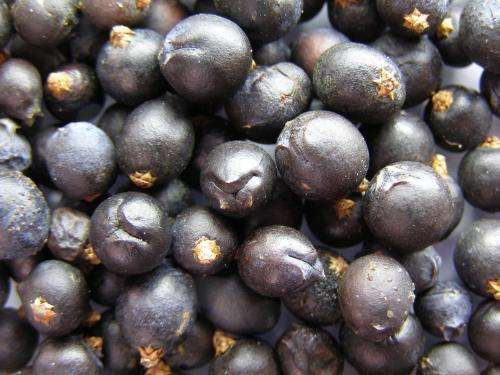Protecting juniper from a berry uncertain future

Forest Research scientists have collected berries from juniper bushes across Great Britain as part of the UK National Tree Seed Project overseen by the Royal Botanic Gardens, Kew. The berries are sent to the Millennium Seed Bank at Kew for conservation and further research. Juniper, one of three conifers native to Britain, is declining due to changes in land use, disease and a long and complicated reproductive cycle.
Scientists from Forest Research, the Forestry Commission's research agency, and volunteers have been scrambling over challenging terrain in nineteen sites across Great Britain from Bulford, Wiltshire to Bitch Craig in the Scottish Borders to collect berries from juniper bushes in a bid to protect them from further decline.
The collection is part of the UK National Tree Seed Project overseen by the Royal Botanic Gardens, Kew. The berries are sent to the Millennium Seed Bank at Kew for conservation and further research. The UK National Tree Seed Project and Millennium Seed Bank have been made possible by £100,000 in support from players of People's Postcode Lottery.
Although there is a lot of juniper in the northern hemisphere, it is declining in Great Britain, particularly in southern England. Rabbits like to eat the seedlings and at some sites the bushes are smothered by brambles and bracken. When moors are burned for grouse shooting it also makes it harder for juniper to survive. The berries often contain large numbers of empty seeds, which may be due an inbalance between male and female bushes in local populations.
Dr Shelagh McCartan of Forest Research who led the berry hunt explains the importance of preserving this native tree:
"Although the juniper berries that flavour our gin traditionally do not come from the UK, and it is rather a rather scraggly, unprepossessing bush; it must be preserved as it is an important part of the Great British landscape. It is one of three native conifers and plays host to about forty fungi and insects, which are dependent on juniper for part or all of their life-cycles. Typically only 6 or so juniper seedlings out of 10,000 seeds survive the first year."

In northern England and Scotland, some juniper populations are under threat from a fungus-like pathogen, Phytophthora austrocedrae.
Frances Graham, Wildlife Conservation Officer of Yorkshire Dales National Park Authority says:
"The UK National Tree Seed Project is an opportunity to safe-guard juniper populations against future threats."
"Good biosecurity protocols are critical to prevent cross-contamination of infected and non-infected juniper populations. It was particularly important for us to surface sterilise collected berries on-site, remove debris from boots and use an appropriate disinfectant on footwear as Phytophthora austrocedrae is soil- and water-borne."
Clare Trivedi, UK National Tree Seed Project Co-ordinator, Kew adds: "It is really great to see the UK National Tree Seed Project get underway. The Forest Research has made a signification contribution to the collecting programme this year and we're looking forward to building our collaboration further in the coming years."
More information: For more information, see www.forestry.gov.uk/fr/INFD-63BCWL
Provided by Forest Research




















